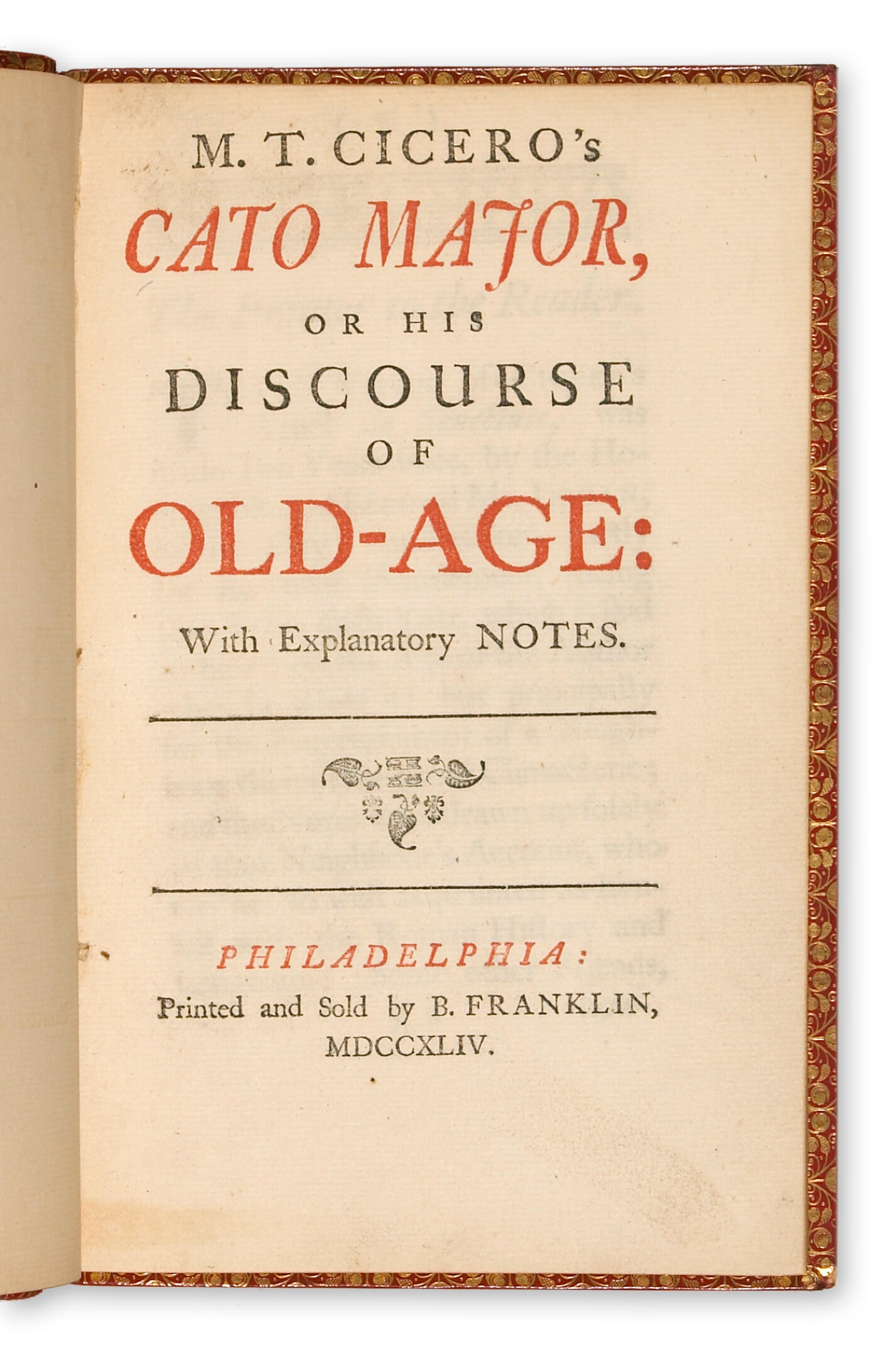FRANKLIN, Benjamin, printer (1706-1790)]. CICERO, Marcus Tullius (106-43 B.C.) M. T. Cicero's Cato Major, or his Discourse of Old-Age: with explanatory notes . Translated by James Logan (1674-1751). Philadelphia: printed and sold by Benjamin Franklin 1744. 4 o (201 x 128 mm). Title-page printed in red and black. (A few insignificant pale foxmarks, small pale stain on rear flyleaf.) Contemporary calf by Joseph Goodwin, Philadelphia (cf. Miller, Appendix C), sides with a blind-tooled double panel of fillet N, cornered by stamp S, roll no. 24 on inner panel and on board edges, spine gilt-ruled and lettered in blind, red speckled edges (slight wear to hinges at ends of spine, light wear to board edges, faint round stain on rear cover); cloth folding case. Provenance : ?Joseph Trumbull (signature on front cover, "Josf. Trum.," possibly Joseph Trumbull (1737-1778) of Connecticut, commissary-general of the Continental Army) -- Hovingham Hall Library (stamp on rear flyleaf). FIRST EDITION, FIRST STATE (with "ony" on page 27), printed on Genoese paper (three circles watermark). James Logan's translation of the Cato Major immediately struck Franklin's fancy when he saw a copy of it. Logan, American scientist, statesman, bibliophile and Franklin's friend, had captured the work in a wholly new fashion. Franklin wrote: "I believed it to be in itself equal at least, if not far preferable to any other Translation of the same Piece extant in our Language, besides the Advantage it has of so many valuable Notes, which at the same time they clear up the Text are highly instructive and entertaining; I resolved to give it an Impression." Franklin was not as readily able to bring it into print, however, for Logan wrote to Peter Collinson in 1742, some five years after the circulating copies began to be known: "I forgot to mention the Cicero de Sen t e. Our ingenious printer B. Franklin about three or four years ago wrote me that he was inclined to print it, on which I revised & altered some of the Parts for the better, & sometime this last winter [1741-42] he sent me the first sheet of it, & this is all I know of the matter." Franklin understood that there was more "honor than profit in this enterprise" (Miller). The result, finally completed when time away from more profitable print jobs permitted, is now generally considered Franklin's typographic masterpiece and with the exception of the almanacs is the best known work from Franklin's press. The present copy was bound by the Philadelphia binder Joseph Goodwin (fl. 1742-1746), whose shop was continued by Nathaniel Holland (fl. 1747-?1752). FINE COPY. Church 949; Evans 5361; Miller 347; Norman 484; Sabin 13040.
FRANKLIN, Benjamin, printer (1706-1790)]. CICERO, Marcus Tullius (106-43 B.C.) M. T. Cicero's Cato Major, or his Discourse of Old-Age: with explanatory notes . Translated by James Logan (1674-1751). Philadelphia: printed and sold by Benjamin Franklin 1744. 4 o (201 x 128 mm). Title-page printed in red and black. (A few insignificant pale foxmarks, small pale stain on rear flyleaf.) Contemporary calf by Joseph Goodwin, Philadelphia (cf. Miller, Appendix C), sides with a blind-tooled double panel of fillet N, cornered by stamp S, roll no. 24 on inner panel and on board edges, spine gilt-ruled and lettered in blind, red speckled edges (slight wear to hinges at ends of spine, light wear to board edges, faint round stain on rear cover); cloth folding case. Provenance : ?Joseph Trumbull (signature on front cover, "Josf. Trum.," possibly Joseph Trumbull (1737-1778) of Connecticut, commissary-general of the Continental Army) -- Hovingham Hall Library (stamp on rear flyleaf). FIRST EDITION, FIRST STATE (with "ony" on page 27), printed on Genoese paper (three circles watermark). James Logan's translation of the Cato Major immediately struck Franklin's fancy when he saw a copy of it. Logan, American scientist, statesman, bibliophile and Franklin's friend, had captured the work in a wholly new fashion. Franklin wrote: "I believed it to be in itself equal at least, if not far preferable to any other Translation of the same Piece extant in our Language, besides the Advantage it has of so many valuable Notes, which at the same time they clear up the Text are highly instructive and entertaining; I resolved to give it an Impression." Franklin was not as readily able to bring it into print, however, for Logan wrote to Peter Collinson in 1742, some five years after the circulating copies began to be known: "I forgot to mention the Cicero de Sen t e. Our ingenious printer B. Franklin about three or four years ago wrote me that he was inclined to print it, on which I revised & altered some of the Parts for the better, & sometime this last winter [1741-42] he sent me the first sheet of it, & this is all I know of the matter." Franklin understood that there was more "honor than profit in this enterprise" (Miller). The result, finally completed when time away from more profitable print jobs permitted, is now generally considered Franklin's typographic masterpiece and with the exception of the almanacs is the best known work from Franklin's press. The present copy was bound by the Philadelphia binder Joseph Goodwin (fl. 1742-1746), whose shop was continued by Nathaniel Holland (fl. 1747-?1752). FINE COPY. Church 949; Evans 5361; Miller 347; Norman 484; Sabin 13040.










.jpg)
.jpg)
.jpg)
Try LotSearch and its premium features for 7 days - without any costs!
Be notified automatically about new items in upcoming auctions.
Create an alert